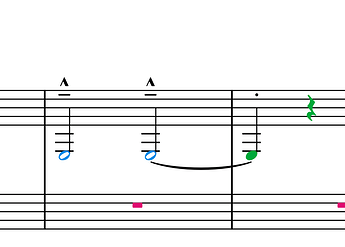Playback not important for now, just need to know how to match
Welcome to the forum @Raymond_Stakenas.
To flip the tenuto and the staccato open the property panel (the lower zone), select a note, and in the articulations section change the placement to stem side.
If you don’t like the tenuto/staccato being inside the staff open Engraving Options > Articulations > Vertical Position > Advanced Options and set the articulations to Do not allow inside staff. But this is global setting and applies to all occurrences of this articulation. To move a single articulation vertically switch to Engrave Mode, select the articulation and move it with ALT/OPTION Arrow-up.
I think @Raymond_Stakenas’s issue is that there’s both a tenuto (“–”) and a staccato (“.”) on the same tied chain, and at different positions… Since those are conflicting articulations, it’s not that easy. I managed to do it by changing the voice of the second note:
but there could be a simpler solution? (possible of course to fake the staccato dot, but I was trying to achieve it with real articulations).
Forgive my ignorance but why a legato marcato?
I wouldn’t know either how to perform the articulations. This combination doesn’t make much sense musically.
The meaning of the tenuto indication varies with the instrument and the context. On the piano, for example, it means to hold the note its full value, but not connect it to the next note. So it could be combined with a marcato accent.
However, some composers have used it to mean a mild accent, unfortunately, which as you and Vadian point out, would make little sense combined with a marcato. Therefore I assume the composer is using it in it proper sense of holding.
The fact that Dorico treats tied notes as one entity has many advantages, but also some unfortunate side effects when articulations and fingerings need to be added later in the chain that would be good to address.
You are correct. It goes with the crescendo Hit the note hard, crescendo through the note value (Hold it out for the full duration) and then end with stopping the reed (clarinet) suddenly. The process is repeated for a couple of measures with decreasing note lengths.
While it looks strange, I’m not sure how else you would write this to get the ‘proper’ interpretation.

